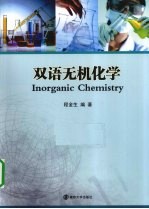

双语无机化学PDF电子书下载
- 电子书积分:11 积分如何计算积分?
- 作 者:程金生编著
- 出 版 社:南京:南京大学出版社
- 出版年份:2010
- ISBN:9787305069772
- 页数:263 页
Introduction 1
0.1 Chemistry:A Science for the 21st Century 2
0.2 Scientific Method of Inorganic Chemistry 3
0.3 The Relationship of Inorganic Chemistry and Other Subjects 3
0.4 How do You Study This Course to Get Well? 3
Exercises 3
Chapter 1 The Behaviors of Gas,Liquid and Solution 4
内容提要 4
1.1 The Properties of Gases 5
1.2 The Properties of Liquid 9
1.3 The Properties of Solutions 14
Exercises 22
Chapter 2 Chemical Thermodynamics 23
内容提要 23
2.1 First Law of Thermodynamics 25
2.2 Second Law of Thermodynamics 27
2.3 Third Law of Thermodynamics 28
2.4 Gibbs Free Energy 29
2.5 Hess's Law 30
Exercises 31
Chapter 3 Chemical Dynamics 33
内容提要 33
3.1 The Rates of Chemical Reactions 35
3.2 Transition State(Eyring,1930's) 40
3.3 Catalysis 41
Exercises 42
Chapter 4 The Ionization Equilibria and Theories of Acids & Bases 44
内容提要 44
4.1 Theories of Acids and Bases 46
4.2 Strong and Weak Bases 49
4.3 Strong and Weak Acids 51
4.4 Common Ion Effect and Buffered Solution 54
4.5 The Dissociation of Weak Polyacids and Hydrolysis of Salts 54
Exercises 55
Chapter 5 The Equilibrium of Precipitation and Dissolution 57
内容提要 57
5.1 Solubility Product 58
5.2 Qsp,Ksp and Saturation 58
5.3 Molar Solubilities and Solubility Products 59
5.4 The Common-Ion Effect 60
5.5 How to Separate Ions by Selective Precipitation 60
5.6 The Simultaneous Equilibria Between Precipitations 61
Exercises 62
Chapter 6 Oxidation-Reduction Reactions & Electrochemistry 63
内容提要 63
6.1 Oxidation-Reduction Reactions 64
6.2 Electrode Potential 67
6.3 Electrochemical Cells 70
6.4 The Nernst Equation 72
6.5 Some Application 74
Exercises 74
Chapter 7 The Atomic Structure and the Periodic Properties of the Elements 76
内容提要 76
7.1 Atom Structure 78
7.2 The Spectrum of Atomic Hydrogen and Bohr's Theory 81
7.3 Atomic Orbitals and Electron Configurations 83
7.4 The Periodic Properties of the Elements 89
Exercises 97
Chapter 8 Chemical Bonds and Structures 98
内容提要 98
8.1 Covalent Bonds 102
8.2 Molecular Geometry 106
8.3 Ionic Bond 111
8.4 The Structures of Crystalline Solids 113
8.5 Metallic Bond 114
8.6 Intermolecular Bonding-Van der Waals Forces 115
8.7 Intermolecular Bonding Hydrogen Bond 118
Exercises 121
Chapter 9 The Main-Group Elements 122
内容提要 122
9.1 Introduction 132
9.2 The Chemistry of Hydrogen 134
9.3 The Alkali Metals(Group 1 or Group IA) 135
9.4 The Alkaline Earth Metals(Group 2) 140
9.5 Boron Group(Group 13) 146
9.6 Carbon Group(Group 14) 153
9.7 Nitrogen Group(Group 15) 159
9.8 Chalcogen Group(Group 16) 170
9.9 Halogens Group(Group 17) 177
9.10 The Noble Gases(Group 18) 183
Exercises 187
Chapter 10 The Transition Metal Elements 189
内容提要 189
10.1 Introduction 195
10.2 Group 4(The Titanium Subgroup) 197
10.3 Group 5(The Vanadium Subgroup) 200
10.4 Group 6(The Chromium Subgroup) 203
10.5 Group 7(The Manganese Subgroup) 207
10.6 Group 8(The Iron Subgroup) 210
10.7 Group 9(The Cobalt Subgroup) 217
10.8 Group 10(The Zine Subgroup) 220
10.9 Group 11(The Copper Subgroup) 223
Exercises 228
Chapter 11 The Lanthanides and Actinides 230
内容提要 230
11.1 Definitions 231
11.2 Periodicity 232
11.3 Lanthanides 232
11.4 Actinides 240
11.5 Uranium Chemistry and Nuclear Chemistry 243
Exercises 247
Chapter 12 Introduction of Bio-Inorganic Chemistry 249
内容提要 249
12.1 Introduction 249
12.2 Major Areas of Bio-Inorganic Chemistry 249
12.3 Biomedicine Application 252
Exercises 253
Appendix A:References and Further Reading 254
Appendix B:International System of Units(SI)and Units Conversion 255
Appendix C:Saturation Vapor Pressure over Water for Different Temperatures 257
Appendix D:Dissociation Constant K for Weak Acid and Weak Base 258
Appendix E:AfHΘm,AfGΘm and SΘm for Some Typical Compounds 259
Appendix F:Solubility-Product Constants(Ksp)of Slightly Soluble Ionic Compounds at 298 K 260
Appendix G:Standard Electrode Potentials in Aqueous Solution 261
Appendix H:Standard Heat of Combustion for Typical Organic Compounds 262
Appendix I:Periodic Table of Elements 263
- 《分析化学》陈怀侠主编 2019
- 《化学反应工程》许志美主编 2019
- 《卓有成效的管理者 中英文双语版》(美)彼得·德鲁克许是祥译;那国毅审校 2019
- 《危险化学品经营单位主要负责人和安全生产管理人员安全培训教材》李隆庭,徐一星主编 2012
- 《奶制品化学及生物化学》(爱尔兰)福克斯(FoxP.F.)等 2019
- 《有机化学实验》雷文 2015
- 《全国普通高等中医药院校药学类专业十三五规划教材 第二轮规划教材 分析化学实验 第2版》池玉梅 2018
- 《生物化学》田余祥主编 2020
- 《长江口物理、化学与生态环境调查图集》于非 2019
- 《化学工程与工艺专业实验指导》郭跃萍主编 2019
